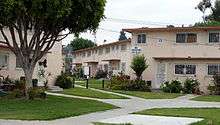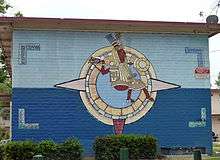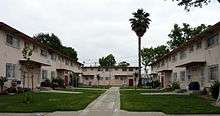Ramona Gardens
Ramona Gardens is a public housing development in the Boyle Heights neighborhood of Los Angeles, California. It is operated by the Housing Authority of the City of Los Angeles. Currently and historically Latino, it is also the home of the Big Hazard street gang, connected to the Mexican Mafia, and has been the center of the illegal drug market in Southern California.

The development abuts the Interstate 10 and is part of LAPD's Hollenbeck Division.
Initial construction
The Ramona Gardens project was designed by Housing Architects Associated, made up of Ralph Flewelling, George J. Adams, Lloyd Wright, Lewis Eugene Wilson, and Eugene Weston Jr.. They had previously designed the Utah Street housing project under the name of Utah Street Architects Association and designed the Aliso Village project under the name Housing Group Architects.[1] The landscaping was by the firm of Bashford and Barlow.[2]
The project was originally named Ramona Village, it was changed in November 1939 because it conflicted with the name of a private land development. At the time, Ramona Gardens was billed a "slum clearance and low-rent housing project".[3] Construction began in February or March 1940, with a groundbreaking ceremony on March 16, 1940 attended by Governor Culbert Olson.[4][5][6][7]
It was built on 32 acres (13 ha) with 610 apartment units in over 100 buildings. The planned cost was $2 million, 90% funded by the United States Housing Authority through the Housing Act of 1937.[8][9][7][6][5][4] It was built by the Herbert M. Baruch Corporation.[10][11]
Demonstration units opened in October 1940,[12] with the first six families occupying apartments on 2 January 1941.[13] It was dedicated on 22 February 1941 with both Governor Olson and Mayor Fletcher Bowron in attendance. At that time, 252 of 610 units were occupied, with the remainder expected to be complete within two months.[14][15] The Christian Science Monitor praised the "home conveniences that many of [the residents] never before enjoyed—electric refrigerators, new gas ranges, gas water heaters, and wall furnaces—at rentals ranging from $11 to $18 a month, including all utilities."[8] Two hundred members of the American Institute of Architects (AIA) toured the development in May 1941, including architect and AIA President Richmond Shreve.[16]
Community efforts and further development

Jewish residents of Boyle Heights started the racially and economically integrated Heights Cooperative Nursery School for Ramona Gardens children in 1949. It was held at the Jewish Cultural Center nearby in City Terrace until Interstate 10 widening required it to be moved in about 1969. The nursery continued operating through at least 1974. It was used as a training school by education students at California State University, Los Angeles and by the Head Start Program.[17]
In 1988, 10 mobile homes or trailers were brought into Ramona Gardens and parked on playfields. They were used as transitional housing for the city's large homeless population. Residents agreed to participate after receiving promises they would be given to families, not "the stereotypical single men who live on Skid Row."[18][19]
After the initial number of 610 housing units in just over 100 buildings, varying numbers of units have been given: 488 units in 1985,[20] 497 with about 2000 predominantly Latino residents in 2007.[21]
The housing contains public murals that were created by the residents of Ramona Gardens between 1973 and 1977, with the assistance of the Mechiano Arts Center.[22][23] At least one was painted by Willie Herron inside the administration building.[23]
In 1982, motivated by President Ronald Reagan, residents repainted every building in the complex in five months. They used tools and paint from the Housing Authority and sponsored by the East Los Angeles Community Development Project. The Big Hazard gang brought in rivals from Avenidas, Dogtown, and Garrity's to work on the project.[24][25] Acknowledging the fresh paint and graffiti-free buildings, the Los Angeles Times named the area as the "center for drug traffic", remarking "users from as far away as San Diego drive to [Ramona Gardens] to buy drugs". PCP was heavily trafficked, but heroin and marijuana were also common. Both dealers and customers were often from outside of the projects but came to Ramona Gardens for the large and open marketplace, called a "24-hour drive-through drug market" by a police officer. Police were assigned on daily foot patrols and would often bring their first arrest to the station within 30 minutes of their shift. A tenants' association was formed, as well as a group called Mothers Against PCP and the federally funded Narcotics Prevention Project.[26][27]
Gang activity, drugs, police tension, and crime

The street gang Big Hazard ("Hazard Grande"), associated with the Mexican Mafia, is from Ramona Gardens.[21] Gang and drug activity historically centered around The Square, an intersection and parking lot in the project.[27][28]
An Alternative Education and Work Center (AEWC) opened at Ramona Gardens in December 1989, giving Big Hazard gang members a place to finish high school, since Lincoln High School is in rival gang territory.[29]
Gang-on-gang crime occurs in and near the park. Two teenagers were shot and stabbed to death while attending a baby shower in January 1974, less than a month after another gang-related shooting fatality.[30]
The housing project is especially known for a pattern of tension between residents, gang members, and police. In 1991, police shot and killed an unarmed gang member, leading to an FBI investigation and grand jury probe of the police department for it and three other police killings.[31][32][21] A firefight between gang members and police in 1996 ended with one gang member dead, a police officer wounded, and an angry crowd. Gang members shot at patrol vehicles in 2006. In 2007, a gang member died while in LAPD custody. The 2007 incident erupted in a riot involving 50 gang members and 100 police equipped in riot control gear.[21]
The housing has also had significant racial tension. In 1967, a 17-year-old "Mexican boy", a suspect to an arson that occurred minutes before, was shot and killed by police. The police showed in large numbers to mediate the tension. The Los Angeles Sentinel said the scene was "an ominous, uneasy silence, like a placid lid resting atop a seething volcano." Further saying that help was being provided to the blacks by the Symbionese Liberation Army, and that the sides "were at war", with only the "strong presence of police officers who live in daily and nightly fear of snipers."[33] Nine days later, the officer was cleared by the coroner's jury as a justifiable shooting.[34] In 1991, two black families were firebombed in a racially motivated incident.[21][35] On May 15, 2014 four apartments in Ramona Gardens were struck by Molotov cocktails. There were no injuries. Most of the victims were African American.
Other crime has occurred. In 1974, four teenagers shot and killed a Thai ice cream vendor in what was called a "thrill killing" while children were waiting for ice cream.[36]
See also
References
- Cuff, Dana (2000). The Provisional City: Los Angeles Stories of Architecture and Urbanism. MIT Press. p. 158. ISBN 0-262-03276-7.
- Keylon, Steven. "Taming the Car — A Vision for Los Angeles: Fred Barlow, Jr.'s Innovative Landscape for Baldwin Hills Village". Eden: Journal of the California Garden and Landscape History Society, vol. 16, no. 1 (Winter 2013).
- "Project Name Changes Made". Los Angeles Times. 27 November 1939. p. A2.
- "Low Rent Housing Project Starts Soon". Los Angeles Times. 31 January 1940. p. 2.
- "Low-Rent Housing Program Will Provide Jobs For 1200". Los Angeles Times. 7 February 1940. p. A3.
- "Ramona Gardens Ceremony Fixed". Los Angeles Times. 12 March 1940. p. A10.
- "Olson Dedicates Housing Project". Los Angeles Times. 17 March 1940. p. 2.
- "Los Angeles Brings 'Luxuries' to Low-Pay Class". The Christian Science Monitor. 21 March 1941. p. 6.
- "Housing Project Rising Rapidly". Los Angeles Times. 2 July 1940. p. 20.
- "Firm Occupies New Building". Los Angeles Times. 9 December 1951. p. F6.
- "Herbert M. Baruch, 61, Contractor, Ends Life". Los Angeles Times. 21 October 1955. p. 4.
- "New Low Cost Housing Unit Is Now Open". Los Angeles Sentinel. 24 October 1940. p. 1.
- "Housing Unit Gets Tenant". Los Angeles Times. 3 January 1941.
- "Dedication of City Housing Project Set". Los Angeles Times. 17 February 1941. p. 10.
- "Housing Fete to Be Today". Los Angeles Times. 23 February 1941. p. 16.
- "Noted Architects Will View Housing Projects". Los Angeles Times. 22 May 1941. p. A10.
- Castro, Mike (15 March 1974). "ONE OF OLDEST IN CITY". Los Angeles Times. p. C1.
- Harris, Scott (30 September 1987). "Mobile Homes for the Poor to Be Located in Projects". Los Angeles Times. p. 8.
- Kelsey, Thomas (24 November 1987). "Metro Digest: Trailers for the Homeless". Los Angeles Times. p. C2.
- Clifford, Frank (9 December 1985). "14th District's Election Lacks Fire but Still Stirs Concerns". Los Angeles Times. p. V1.
- Pringle, Paul (16 February 2007). "Mired in violence at Ramona Gardens; Neither police nor a gang gives ground at L.A.'s oldest project". Los Angeles Times. p. A1.
- "The Murals and Culture of Ramona Gardens". Mapping Los Angeles Public Art. Retrieved 27 April 2011.
- Del Olmo, Frank (3 December 1973). "Murals Changing Face of East L.A.". Los Angeles Times. p. B1.
- Smith, Dave (11 September 1983). "Housing Project's War on Graffiti Over and Won: Ramona Gardens Celebrates Its Victory". Los Angeles Times. p. B7. Missing or empty
|url=(help) - Smith, Dave (11 September 1983). "Housing Project Wins Graffiti War". Los Angeles Times. p. OC_A11.
- "Garden Spot in the Making". Los Angeles Times. 6 July 1984. p. C6.
- Igler, Marc (5 July 1984). "Ramona Gardens: Center for Drug Traffic". Los Angeles Times. p. D1.
- Furillo, Andy (13 October 1984). "Police Arrest 23 in PCP Raid at 'The Square' in Boyle Heights". Los Angeles Times. p. A32.
- Walker, Jill (11 April 1990). "New Schools for Gangs Pose Unique Segregation Concern". Washington Post. p. A3.
- "2 TEEN-AGE GANG MEMBERS SLAIN; REPRISALS FEARED". Los Angeles Times. 21 January 1974. p. A3.
- "Residents Seek Inquiry Into Police Shooting". New York Times. Associated Press. 5 August 1991. p. A11.
- "Feds Probe Sheriff's Killings of Four Men". Los Angeles Sentinel. 20 February 1992. p. A15.
- "The Inside Story". Los Angeles Sentinel. 1 June 1967. p. D4.
- "POLICEMAN CLEARED IN SLAYING OF YOUTH". Los Angeles Times. 10 June 1967. p. 2.
- "D.A. To Investigate Racially-Motivated Firebombings". Atlanta Daily World. UPI. 24 September 1992.
- Burke, Kathy (30 October 1974). "Ice Cream Vendor Shot to Death in His Truck". Los Angeles Times. p. 3.
External links
- L.A. Community Starved For Healthful Food Options on All Things Considered by Mandalit Del Barco
- The Murals of Ramona Gardens at the Mural Conservancy of Los Angeles
- Photograph of Ramona Gardens at University of Southern California (USC)
- Photograph of Ramona Gardens at USC